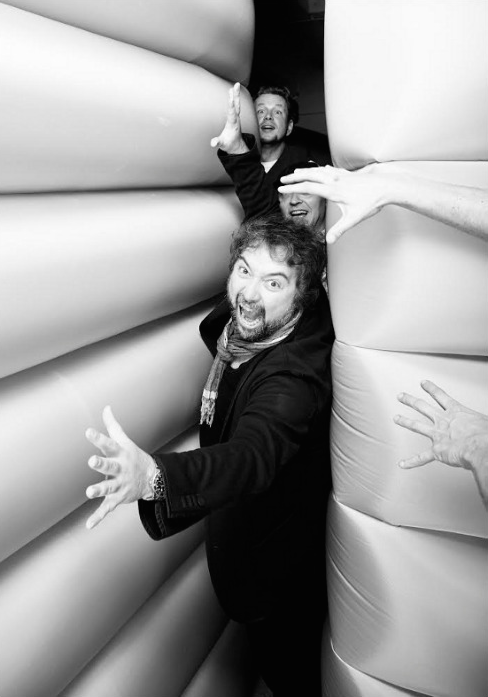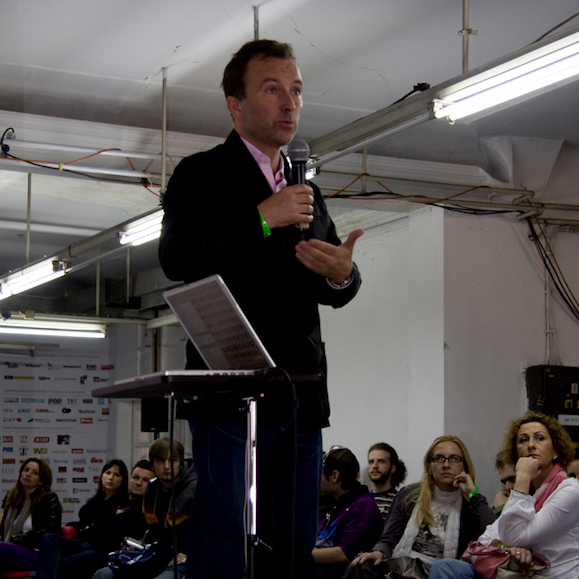
INTERVIEW WITH JOVAN JELOVAC – BUSINESS MAGAZINE
Jovan Jelovac: Branding stands no lie
Corporations have improved their doing business to such an extent that now every table, juice, coffee, shirt, apart from the instructions for use, must also contain a „romanticized biography“ if they want success on the market
The Belgrade Design Week 2007. will be held, for the first time, from 7th to 12th May and will again bring together some of the most prominent world known names in the area of branding, advertising, architecture, design and publishing. Ambitiously conceived as a combination of the business and educational conference, “change2” will offer exhibitions, premieres and presentations throughout Belgrade within the city festival of culture “Belgrade Squared (Belgrade2)”.
Author of the idea and initiator of this festival of a kind of all contemporary disciplines which contribute to branding is Jovan Jelovac, an expert for branding, owner of Trans East Company. He recently made a comment while announcing this year’s May “Belgrade Design Week” that it is very important that in the region of 50 million people, from Milan to Istanbul, precisely in Belgrade as a central point the change of the world is explained by means of – design and creativity.
In the interview for Magazin Biznis Jelovac says that in the previous years there has been a boom of quality in design and branding in the world. A true heaven for consumers:
– The design has never been of a better quality, the prices of products have never been lower, the trainers have never been more comfortable, and the clothes we wear have never been more chic or more functional. There is a simple reason: great thought of the designers has been invested into design and branding – Jelovac says.
The contemporary presentation of companies has introduced two concepts into use: branding and advertising. What is more important?
– In the developed world these things go together. Branding cannot stand alone, without advertising. Branding comprises the complete presentation of a company on the market, but that implies everything – from the way in which the employees answer the phone to how they direct their PR policies. If the company is big, it is all the more important. However, in Serbia this is not the case. Many already well known companies work little on their branding, but more on advertising (advertisements), which can often be counterproductive.
The opponents of marketing usually cite the famous Goebbels’s maxim:” The truth is not important, but its appearance. If people do not believe that, you should repeat it”. Maybe it sounds too harsh, but – to what extent are consumers today the victims of marketing?
– Well, the aforementioned formulation contains the key which helps to explain the difference between advertising and branding. Namely, the advertisement is what seduces and makes people victims. Branding is not allowed to do that. Branding is a category which does not stand a lie. Branding is the truth on what the advantages of a product are, that is, what is the truth about a product. For, the life of the contemporary consumer can be very complicated. The products and the buyers can become very disunited, distanced from one another because of the modern way of living. For that reason they need a “translator”, and interpreter and that is – branding. Why is it important? Because branding is the first to distill what to choose in the incredible offer of many television sets on the market and provides an answer to the question- why a certain television set precisely is important. Branding, therefore, explains the core value of a product.
Are branding and advertising the symbols of the “new economy” which has ruled the world in the past 15 years or so?
– They absolutely are. That came about in a very simple way. All the producers have become fantastically good. Now it is no longer a problem to produce something. The contemporary technological development has perfected the production of almost everything you can imagine. But in all that, in the springing up of new products, those who functionally change the world are few. The only thing left to make a distinction between one object and another is the design. That is to say, questions such as who designed it, whether there is a name or an interesting history behind it. We now treat objects with usability in the same way we treat art. In that way branding has improved much in the past 15 years or so. Corporations have improved their trade to such an extent that now every table, juice, coffee, shirt, apart from the manual must also contain a “romanticized biography” if they want to succeed in the market. That “romanticized biography” is what is called branding.
To what extent have all of us, as a developed consumer society, become slaves to design and branding?
– That is a good slavery. The whole point of a brand is that there are not longer non- standard products. The problem of abundance is now whether we need ten new models of a bag by a world famous name very year, or, if a new collection something on the market is always necessary because, appear on the market, you have nothing. For that reason we are witnesses to an incredible production of new things. Advertising is another story. Waiters who sell the yesterday’s chicken to a guest, and he will take it instead of the today’s salmon have the best advertising in the world. But the team which deals in the design and quality of the products in companies has advanced to such an extent, that their power has become quite big. Therefore it is logical that we have become a consumer society. The choice is very good and many quality things which make our life easier and more beautiful are on offer.
How far can this process go? Is there no iceberg into which the “Titanic” of brand production will run?
– Except for, perhaps, the ecological danger, I do not see any “icebergs”. On the contrary, in branding I see the renaissance or the revolution. That turnover has already taken place. The new, young artists are getting better and better. The concentration of quality in London, Milan, New York, and Shanghai …is amazing. My task is to bring a part of that knowledge to Belgrade, to the “Belgrade Design Week”. People who have achieved much will come. They have made brands from their companies. Unless we want to become the importers of everything there is, we do not need only one design week a year, but at least two. For instance, Gaya from Istanbul who had a small factory, worse than the ceramics factory from Mladenovac is, is coming to our “Design Week”. The first question she asked herself was- Surely I won’t be producing this for the rest of my life? Afterwards she gathered the people who were designing many ceramic products and now “Gaia & Gino” have around 10,000 shopping places from Singapore to New York. She will be only one of the guests of the “Belgrade Design Week”. That is why it is important that our businessmen come and hear that story.
What about the well known story that there are many talented, creative people in Serbia?
– That is a romantic account of the Serbian “creative savage” who only lacks a good system, but who would otherwise “blow away” any of his/her colleagues from “the wide world”. Well, that creativity that we put into legends ends up in our humorous conversations, jokes and the speed of telling them. But it is like that everywhere – in Paris as well as Buenos Aires. There also such ”phenomena” exist. That is the reason why this Serbian creativity is one of the worst myths ever created. Many Serbian managers are among the most uninformed people, because they have a myth about their own genius. The problem is additionally increased by the fact that almost everyone of value in this country has left Serbia and is creative in other parts of the world. That is the reason why Serbia when it comes to its creativity does not exist on the world map. But it is true that our communicative powers exist and that we have potential. That is the reason why we are organizing the “Belgrade Design Week”, in order to open the market and that Serbia gets a chance. “London Design Week” receives 1.4 million pounds from the city of London per year, only to enable the meeting of designers and businessmen, in order to enable the contact with the economy of the whole world, and that people come and gain new knowledge. We are still far away from that, but it does not mean that we should give up. This year’s, the second “Belgrade Design Week” is one more step in that direction.
Trackback from your site.
